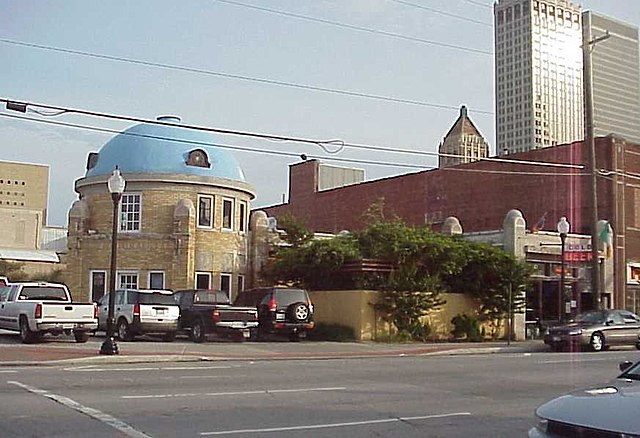Downtown Tulsa is an area of approximately 1.4 square miles (3.6 km2) surrounded by an inner-dispersal loop created by Interstate 244, US 64 and US 75. The area serves as Tulsa's financial and business district; it is the focus of a large initiative to draw tourism, which includes plans to capitalize on the area's historic architecture. Much of Tulsa's convention space is located in downtown, such as the Tulsa Performing Arts Center and the Tulsa Convention Center, as well as the BOK Center. Prominent downtown sub-districts include the Blue Dome District, the Tulsa Arts District, and the Greenwood Historical District, which includes the site of ONEOK Field, a baseball stadium for the Tulsa Drillers opened in 2010.
The Blue Dome, a former Gulf Oil Service Station, built in 1924.
Cain's Ballroom
The Dennis R. Neill Equality Center in the East Village District in Downtown Tulsa/Tvlse, Creek Nation-Oklahoma
Downtown Tulsa
U.S. Route 64 in Oklahoma
U.S. Route 64 (US-64) is a U.S. highway running from the Four Corners area to the Outer Banks of North Carolina. Between these two points, the highway passes through the entire width of Oklahoma; a total of 591.17 miles (951.40 km) of US-64 lies in the state of Oklahoma. US-64 enters the state from New Mexico, crossing the line between the two states between Clayton, New Mexico, and Boise City in Cimarron County. The route runs the full length of the Oklahoma Panhandle, then serves the northernmost tier of counties in the main body of the state before dipping southeastward to Tulsa, the state's second-largest city. From Tulsa, the highway continues southeast, leaving Oklahoma just west of Fort Smith, Arkansas. In addition to Tulsa, US-64 serves fifteen Oklahoma counties and the cities of Guymon, Woodward, Enid, and Muskogee.
US-64 east of Boise City
US-64 in Woods County
US Route 64 and State Highway 18 in Oklahoma







